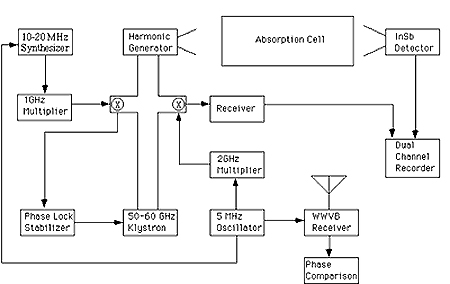Tunable, high resolution techniques and spectroscopy were extended into the submillimeter region more than 40 years ago by the Microwave Laboratory (74, 82) (the reference numbers are keyed to the bibliography). This technology was based upon semiconductor harmonic generators and point contact diode detectors. With these techniques most of the fundamental linear and symmetric top species were studied. In addition, many measurements on important species such as water ( 88), oxygen (46, 52), ozone (75), etc. were made. A comprehensive summary of these results was published by Gordy (247). The introduction of liquid helium temperature detectors into these systems (283) significantly improved their sensitivity and reliability. This combination of phase-locked harmonic generator source and sensitive helium temperature detector has been extremely successful and has been widely adopted. (See also Claude Woods, Lucy Ziurys, and JPL Molecular Spectroscopy Home Page) More recently, a number of additional improvements have been reported (368).
 Among the earliest studies with systems similar to that shown in the
figure were the isotopes of water and hydrogen sulfide
(289, 291, 294, 295,
299). This work was the first for light molecules
in which modern centrifugal distortion theory, statistical and computational
methods, and extensive experimental data sets were combined in order to
produce models capable of calculating unobserved lines to microwave accuracy.
This system was also used to make the first pressure broadening studies in the
submillimeter spectral region (339) and
Among the earliest studies with systems similar to that shown in the
figure were the isotopes of water and hydrogen sulfide
(289, 291, 294, 295,
299). This work was the first for light molecules
in which modern centrifugal distortion theory, statistical and computational
methods, and extensive experimental data sets were combined in order to
produce models capable of calculating unobserved lines to microwave accuracy.
This system was also used to make the first pressure broadening studies in the
submillimeter spectral region (339) and
The magnetically lengthened negative glow (see Ion Production Environment) approach has been used to study a number of ions. The gains in ion density produced by this technique, coupled with the gains in sensitivity achievable at shorter wavelengths change the required search times for new ions by orders of magnitude and have brought many new ions beyond their threshold for study. For example, even though the signal strength of ArD+ is much more than an order of magnitude weaker than that of the "standard" molecular ions (HCO+ , N2H+ , etc.), it has been possible to observe both 36ArD+ (abundance 1/298) and 38ArD+ (abundance 1/1590) in natural abundance with only modest signal averaging (~1 minute) and HC18O+ (abundance 1/490) in real time on an oscilloscope and HC17O+ (abundance 1/2674).
These data have also been included in the widely used Jet Propulsion Laboratory spectral line catalogue.
Other Related Sites
Return to The Microwave Laboratory